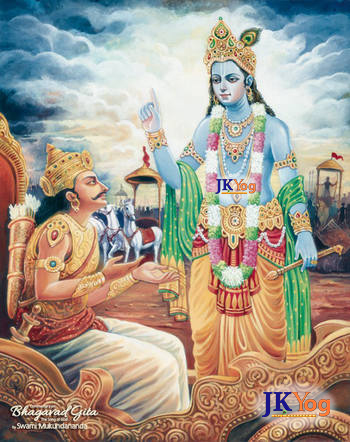

यत्र काले त्वनावृत्तिमावृत्तिं चैव योगिन: |
प्रयाता यान्ति तं कालं वक्ष्यामि भरतर्षभ || 23||
अग्निर्ज्योतिरह: शुक्ल: षण्मासा उत्तरायणम् |
तत्र प्रयाता गच्छन्ति ब्रह्म ब्रह्मविदो जना: || 24||
धूमो रात्रिस्तथा कृष्ण: षण्मासा दक्षिणायनम् |
तत्र चान्द्रमसं ज्योतिर्योगी प्राप्य निवर्तते || 25||
शुक्लकृष्णे गती ह्येते जगत: शाश्वते मते |
एकया यात्यनावृत्तिमन्ययावर्तते पुन: || 26||
yatra kāle tvanāvṛittim āvṛittiṁ chaiva yoginaḥ
prayātā yānti taṁ kālaṁ vakṣhyāmi bharatarṣhabha
agnir jyotir ahaḥ śhuklaḥ ṣhaṇ-māsā uttarāyaṇam
tatra prayātā gachchhanti brahma brahma-vido janāḥ
dhūmo rātris tathā kṛiṣhṇaḥ ṣhaṇ-māsā dakṣhiṇāyanam
tatra chāndramasaṁ jyotir yogī prāpya nivartate
śhukla-kṛiṣhṇe gatī hyete jagataḥ śhāśhvate mate
ekayā yātyanāvṛittim anyayāvartate punaḥ
yatra kale tvanavrittim avrittim chaiva yoginah
prayata yanti tam kalam vakshyami bharatarshabha
agnir jyotir ahah shuklah shan-masa uttarayanam
tatra prayata gachchhanti brahma brahma-vido janah
dhumo ratris tatha krishnah shan-masa dakshinayanam
tatra chandramasam jyotir yogi prapya nivartate
shukla-krishne gati hyete jagatah shashvate mate
ekaya yatyanavrittim anyayavartate punah
BG 8.23-26: I shall now describe to you the different paths of passing away from this world, O best of the Bharatas, one of which leads to liberation and the other leads to rebirth. Those who know the Supreme Brahman and who depart from this world, during the six months of the sun’s northern course, the bright fortnight of the moon, and the bright part of the day, attain the supreme destination. The practitioners of Vedic rituals, who pass away during the six months of the sun’s southern course, the dark fortnight of the moon, the time of smoke, the night, attain the celestial abodes. After enjoying celestial pleasures, they again return to the earth. These two, bright and dark paths, always exist in this world. The way of light leads to liberation and the way of darkness leads to rebirth.

Start your day with a nugget of timeless inspiring wisdom from the Holy Bhagavad Gita delivered straight to your email!
In these verses, Shree Krishna continues to answer the question Arjun had asked in verse 8.2, “How can one be united with God at the time of death?”
Shree Krishna explains that there are two paths—the path of light or the path of darkness. Although these statements may seem cryptic, they present an effective allegory to explain spiritual concepts using the contrasting themes: light and darkness. Where light; is symbolic to knowledge and darkness; is for ignorance.
The bright daylight, the moonlit fortnight of śhuklaḥ or the bright ascending moon, and the uttaraayan, the northern course of the sun, are all considered the time of light. The God-conscious souls; who detach from worldly attachments and depart by the path of light (knowledge and discrimination) attain God. They are liberated from the wheel of samsara, the cycle of life and death, and reach the divine Abode of God.
The ignorant souls who are attached to the world remain entangled in the bodily concept of life. They forget their relationship with God. Such souls depart by the path of darkness. Hence, continue to rotate in the cycle of life and death. However, those who may have undertaken some Vedic rituals, as its fruit, go to the celestial abodes. But this position is also part of the material world, thus temporary. When their merits are exhausted, they have to return to earth. Ultimately all humans born on earth, upon death, have to pass along either of the two paths, the path of light or the path of darkness. It is their karmas that decide which path they would take eventually.